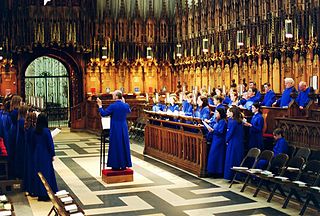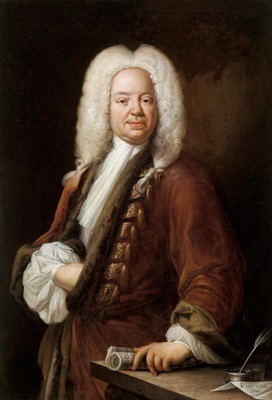Related Research Articles

In music theory, counterpoint is the relationship of two or more simultaneous musical lines that are harmonically interdependent yet independent in rhythm and melodic contour. The term originates from the Latin punctus contra punctum meaning "point against point", i.e. "note against note". John Rahn describes counterpoint as follows:
It is hard to write a beautiful song. It is harder to write several individually beautiful songs that, when sung simultaneously, sound as a more beautiful polyphonic whole. The internal structures that create each of the voices separately must contribute to the emergent structure of the polyphony, which in turn must reinforce and comment on the structures of the individual voices. The way that is accomplished in detail is ... 'counterpoint'.

In classical music, a fugue is a contrapuntal, polyphonic compositional technique in two or more voices, built on a subject that is introduced at the beginning in imitation, which recurs frequently throughout the course of the composition. It is not to be confused with a fuguing tune, which is a style of song popularized by and mostly limited to early American music and West Gallery music. A fugue usually has three main sections: an exposition, a development, and a final entry that contains the return of the subject in the fugue's tonic key. Fugues can also have episodes, which are parts of the fugue where new material often based on the subject is heard; a stretto, when the fugue's subject overlaps itself in different voices, or a recapitulation. A popular compositional technique in the Baroque era, the fugue was fundamental in showing mastery of harmony and tonality as it presented counterpoint.

Polyphony is a type of musical texture consisting of two or more simultaneous lines of independent melody, as opposed to a musical texture with just one voice (monophony) or a texture with one dominant melodic voice accompanied by chords (homophony).

A choir, also known as a chorale or chorus is a musical ensemble of singers. Choral music, in turn, is the music written specifically for such an ensemble to perform or in other words is the music performed by the ensemble. Choirs may perform music from the classical music repertoire, which spans from the medieval era to the present, or popular music repertoire. Most choirs are led by a conductor, who leads the performances with arm, hand, and facial gestures.
The musical term alto, meaning "high" in Italian, historically refers to the contrapuntal part higher than the tenor and its associated vocal range. In four-part voice leading alto is the second-highest part, sung in choruses by either low women's or high men's voices. In vocal classification these are usually called contralto and male alto or countertenor.

Vespro della Beata Vergine, SV 206, is a musical setting by Claudio Monteverdi of the evening vespers on Marian feasts, scored for soloists, choirs, and orchestra. It is an ambitious work in scope and in its variety of style and scoring, and has a duration of around 90 minutes. Published in Venice as Sanctissimae Virgini Missa senis vocibus ac Vesperae pluribus decantandae, cum nonnullis sacris concentibus, ad Sacella sive Principum Cubicula accommodata, it is sometimes called Monteverdi's Vespers of 1610.
A variety of musical terms are encountered in printed scores, music reviews, and program notes. Most of the terms are Italian, in accordance with the Italian origins of many European musical conventions. Sometimes, the special musical meanings of these phrases differ from the original or current Italian meanings. Most of the other terms are taken from French and German, indicated by Fr. and Ger., respectively.
Georgia has rich and still vibrant traditional music, primarily known for arguably the earliest polyphonic tradition of the Christian world. Situated on the border of Europe and Asia, Georgia is also the home of a variety of urban singing styles with a mixture of native polyphony, Middle Eastern monophony and late European harmonic languages. Georgian performers are well represented in the world's leading opera troupes and concert stages.

A metrical psalter is a kind of Bible translation: a book containing a verse translation of all or part of the Book of Psalms in vernacular poetry, meant to be sung as hymns in a church. Some metrical psalters include melodies or harmonisations. The composition of metrical psalters was a large enterprise of the Protestant Reformation, especially in its Calvinist manifestation.
In Western music and music theory, augmentation is the lengthening of a note or the widening of an interval.

Jesu, der du meine Seele, BWV 78, is a church cantata by Johann Sebastian Bach. He composed it in Leipzig for the 14th Sunday after Trinity and first performed it on 10 September 1724. It is based on the 1641 hymn by Johann Rist, "Jesu, der du meine Seele", for which it is named. The topic of the chorale, the Passion of Jesus cleansing the believer, is only distantly related to the Sunday's readings.
Antonius Divitis was a Flemish composer of the Renaissance, of the generation slightly younger than Josquin des Prez. He was important in the development of the parody mass.

The Missa de Beata Virgine is a musical setting of the Ordinary of the Mass, by Renaissance composer Josquin des Prez. Though formerly believed to have been a late composition on the basis of stylistic analysis, evidence from Burchard’s Diary proves that the mass was written sometime before September 23, 1497. It was the most popular of his masses in the 16th century.
In the years centering on 1600 in Europe, several distinct shifts emerged in ways of thinking about the purposes, writing and performance of music. Partly these changes were revolutionary, deliberately instigated by a group of intellectuals in Florence known as the Florentine Camerata, and partly they were evolutionary, in that precursors of the new Baroque style can be found far back in the Renaissance, and the changes merely built on extant forms and practices. The transitions emanated from the cultural centers of Northern Italy, then spread to Rome, France, Germany, and Spain, and lastly reached England . In terms of instrumental music, shifts in four discrete areas can be observed: idiomatic writing, texture, instrument use, and orchestration.

The Missa prolationum is a musical setting of the Ordinary of the Mass by Johannes Ockeghem, dating from the second half of the 15th century. Based on freely written material probably composed by Ockeghem himself, and consisting entirely of mensuration canons, it has been called "perhaps the most extraordinary contrapuntal achievement of the fifteenth century", and was possibly the first multi-part work written with a unifying canonic principle for all its movements.
Cornelius Canis was a Franco-Flemish composer, singer, and choir director of the Renaissance, active for much of his life in the Grande Chapelle, the imperial Habsburg music establishment during the reign of Emperor Charles V. He brought the compositional style of the mid-16th century Franco-Flemish school, with its elaborate imitative polyphony, together with the lightness and clarity of the Parisian chanson, and he was one of the few composers of the time to write chansons in both the French and Franco-Flemish idioms.
In music theory, an inversion is a rearrangement of the top-to-bottom elements in an interval, a chord, a melody, or a group of contrapuntal lines of music. In each of these cases, "inversion" has a distinct but related meaning. The concept of inversion also plays an important role in musical set theory.

Georg Caspar Schürmann was a German Baroque composer. His name also appears as Schurmann and in Hochdeutsch as Scheuermann.
Giovanni Battista Vitali was an Italian composer and violone player.
References
- ↑ Julie Anne Sadie Companion to Baroque Music 1998 0520214145 p.71 "... which could be expanded to an apocalyptic 144,000, singing at different speeds and in different metres; Kircher cited these ..."